23 Feb EB-1A Petition Approved for Researcher with 7 Publications
Case Type: EB-1A Extraordinary Ability Aliens
Nationality: India
Education: Ph.D.
Field of expertise: Molecular signaling in platelet-mediated hemostasis and thrombosis
Publications: 7
Citations: 108
Review Activities: 7 articles
To establish eligibility for a #green card (lawful permanent residency) based on extraordinary ability, a foreign national must prove extraordinary ability in the sciences, arts, education, business, or athletics through sustained national or international acclaim; achievements recognized in the field through extensive documentation; that the foreign national is one of that small percentage who has risen to the very top of the field of endeavor; that the foreign national seeks to enter the U.S. to continue work in the area of extraordinary ability; and that the foreign national’s entry into the U.S. will substantially benefit the U.S. in the future.
A category that nearly all foreign nationals try to meet for an EB-1A Extraordinary Ability Aliens Petition is “original scientific contributions of major significance”. This can be a challenging category to meet for researchers without a significant number of publications.
In preparing an EB-1A Petition for individuals without a significant number of publications, it is important to stress to USCIS other aspects of achievement that represent original scientific contributions of major significance. We received an approval for an EB-1A petition for a researcher with only 7 total publications but whose research accomplishments include the discovery of multiple drugs targets against thrombosis and hemostasis that major pharmaceutical companies are using in clinical trials for the development of drugs against cardiovascular disease. We effectively demonstrated to USCIS that the millions of dollars being spent to develop drugs based on our client’s research represent original scientific contributions of major significance.
Our client is a national of India who obtained a Ph.D. Degree in the U.S. and currently works at a well-known U.S. University as a postdoctoral research fellow. She was found to be among the small percentage of #researchers at the very top of the field of molecular signaling in platelet-mediated hemostasis and thrombosis. Her research findings have led to multiple new drug targets for the treatment of thrombosis-related disease that have far reaching clinical implications in the U.S. and worldwide.
Our client had multiple memberships in associations that require outstanding achievement of their members and had her 7 publications. Our client had also judged the work of others and we demonstrated that she was selected to do this based on her accomplishments. We obtained a letter from the Editor in Chief of an international journal in which our client had conducted reviews setting forth her review activity which indicated that “only the very top hematologists in the world with their own original scientific contributions of major significance are asked to review and judge the work of others for our journal”, that the number of reviews conducted depends upon the number of publications submitted, and that “the number of manuscripts one reviews is in no way a reflection of one’s expertise of their placement in the field”. To prove that applicant was selected based on an intimate knowledge of her work as opposed to the journal only being aware of her work in a broader context, the letter indicated that the author used applicant’s findings to further his own research so clearly he was “intimately familiar” with her research findings in making the determination to invite her to peer review for the journal. We also submitted the e-mail correspondence between our client and the journal regarding her reviews.
In order to demonstrate original #scientific contributions of major significance we proffered several different types of evidence including reference letters from internationally renowned independent experts in our client’s field from Universities around the world, major international pharmaceutical companies, and U.S. governmental agencies. We explained the importance of our client’s research in simple terms as the #immigration officers who decide EB-1A researcher cases are not experts in science and do not have scientific backgrounds. Many lawyers and researchers who file without a lawyer make the mistake of assuming that they can discuss research accomplishments without providing simple explanations and this mistake can lead to denials. We also provided evidence of our client’s international conference presentations.
Furthermore, our client discovered three drug targets which resulted in the development of three drug molecules against those targets, all of which are in preclinical/clinical trials and we obtained evidence of same. Our client had also received a Young Investigator Award which does not count in the “awards” category because it is not open to all researchers in the field but which we utilized to show a pattern of sustained international acclaim.
Additionally, we provided a citing articles summary for our client’s publications showing that her 7 publications had been cited more than 100 times by numerous investigators around the world objectively demonstrating the significant impact of her work in the international scientific community.
In support of our client’s extraordinary ability, we argued in the petition that all of the publications, citations, presentations, memberships, review activity, and clinical trials should be taken together in determining applicant’s eligibility for EB-1A and emphasized the extraordinary quality of the publications with letters from individuals around the world indicating that they did not just reference our client’s publications but rather that they could not have conducted their own research had it not been for our client’s findings.
Considering all of the evidence cumulatively, USCIS approved our client’s EB-1A petition finding that she met 3 of the enumerated EB-1A statutory categories and that based on the totality of the circumstances she met the high level of achievement required for EB-1A approval.

